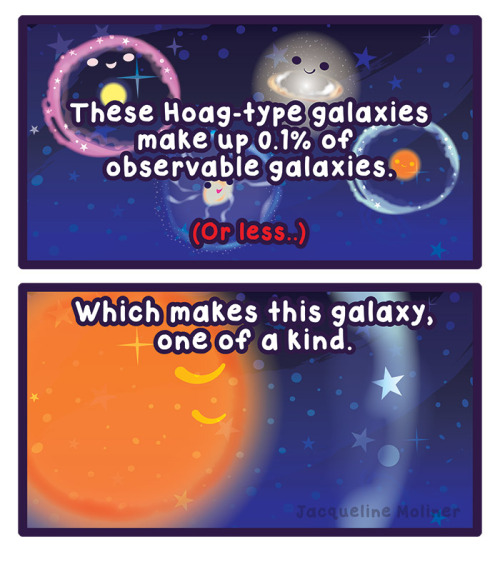The Last Look Before Her Descent In Fire…

The last look before her descent in fire…
More Posts from Fillthevoid-with-space and Others
Ongoing Space Science Seeks to Keep Astronauts Healthy
ISS - Expedition 50 Mission patch. March 10, 2017 NASA is preparing for longer human journeys deeper into space and is exploring how to keep astronauts healthy and productive. The Expedition 50 crew members today studied space nutrition, measured their bodies and checked their eyes to learn how to adapt to living in space. The space residents also unloaded a cargo ship, worked on the Tranquility module and practiced an emergency simulation. The ongoing Energy experiment that ESA astronaut Thomas Pesquet collected urine samples for today seeks to define the energy requirements necessary to keep an astronaut successful during a space mission. Pesquet also joined NASA astronaut Peggy Whitson for body measurements to learn how microgravity affects body shape and impacts crew suit sizing. Commander Shane Kimbrough checked his eyes today with Whitson’s help and support from experts on the ground.
Image above: Astronaut Shane Kimbrough and Thomas Pesquet were pictured inside the cupola just after the SpaceX Dragon was captured Feb. 23, 2017. Image Credit: NASA. Kimbrough worked throughout the day before his eye checks and configured the Tranquility module for upcoming electronics and communications work. Cosmonaut Oleg Novitskiy continued unloading gear from the newly-arrived Progress 66 cargo ship. At the end of the day, Novitskiy joined Whitson and Pesquet for an emergency simulation with inputs from control centers in Houston and Moscow. Related links: Energy experiment: https://www.nasa.gov/mission_pages/station/research/experiments/397.html Body measurements: https://www.nasa.gov/mission_pages/station/research/experiments/1070.html Space Station Research and Technology: https://www.nasa.gov/mission_pages/station/research/index.html International Space Station (ISS): https://www.nasa.gov/mission_pages/station/main/index.html Image (mentioned), Text, Credits: NASA/Mark Garcia. Best regards, Orbiter.ch Full article
Merging Galaxies Have Enshrouded Black Holes
NASA - NuStar Mission patch. May 9, 2017 Black holes get a bad rap in popular culture for swallowing everything in their environments. In reality, stars, gas and dust can orbit black holes for long periods of time, until a major disruption pushes the material in. A merger of two galaxies is one such disruption. As the galaxies combine and their central black holes approach each other, gas and dust in the vicinity are pushed onto their respective black holes. An enormous amount of high-energy radiation is released as material spirals rapidly toward the hungry black hole, which becomes what astronomers call an active galactic nucleus (AGN). A study using NASA’s NuSTAR telescope shows that in the late stages of galaxy mergers, so much gas and dust falls toward a black hole that the extremely bright AGN is enshrouded. The combined effect of the gravity of the two galaxies slows the rotational speeds of gas and dust that would otherwise be orbiting freely. This loss of energy makes the material fall onto the black hole.
Image above: This illustration compares growing supermassive black holes in two different kinds of galaxies. A growing supermassive black hole in a normal galaxy would have a donut-shaped structure of gas and dust around it (left). In a merging galaxy, a sphere of material obscures the black hole (right). Image Credits: National Astronomical Observatory of Japan. “The further along the merger is, the more enshrouded the AGN will be,” said Claudio Ricci, lead author of the study published in the Monthly Notices Royal Astronomical Society. “Galaxies that are far along in the merging process are completely covered in a cocoon of gas and dust.” Ricci and colleagues observed the penetrating high-energy X-ray emission from 52 galaxies. About half of them were in the later stages of merging. Because NuSTAR is very sensitive to detecting the highest-energy X-rays, it was critical in establishing how much light escapes the sphere of gas and dust covering an AGN. The study was published in the Monthly Notices of the Royal Astronomical Society. Researchers compared NuSTAR observations of the galaxies with data from NASA’s Swift and Chandra and ESA’s XMM-Newton observatories, which look at lower energy components of the X-ray spectrum. If high-energy X-rays are detected from a galaxy, but low-energy X-rays are not, that is a sign that an AGN is heavily obscured.
NASA’s NuSTAR telescope. Image Credit: NASA
The study helps confirm the longstanding idea that an AGN’s black hole does most of its eating while enshrouded during the late stages of a merger. “A supermassive black hole grows rapidly during these mergers,” Ricci said. “The results further our understanding of the mysterious origins of the relationship between a black hole and its host galaxy.” NuSTAR is a Small Explorer mission led by Caltech and managed by NASA’s Jet Propulsion Laboratory for NASA’s Science Mission Directorate in Washington. NuSTAR was developed in partnership with the Danish Technical University and the Italian Space Agency (ASI). The spacecraft was built by Orbital Sciences Corp., Dulles, Virginia. NuSTAR’s mission operations center is at UC Berkeley, and the official data archive is at NASA’s High Energy Astrophysics Science Archive Research Center. ASI provides the mission’s ground station and a mirror archive. JPL is managed by Caltech for NASA. Related link: Monthly Notices of the Royal Astronomical Society: https://academic.oup.com/mnras/article/468/2/1273/2939810/Growing-supermassive-black-holes-in-the-late For more information on NuSTAR, visit: http://www.nasa.gov/nustar http://www.nustar.caltech.edu Images (mentioned), Text, Credits: NASA/Tony Greicius/JPL/Elizabeth Landau. Greetings, Orbiter.ch Full article




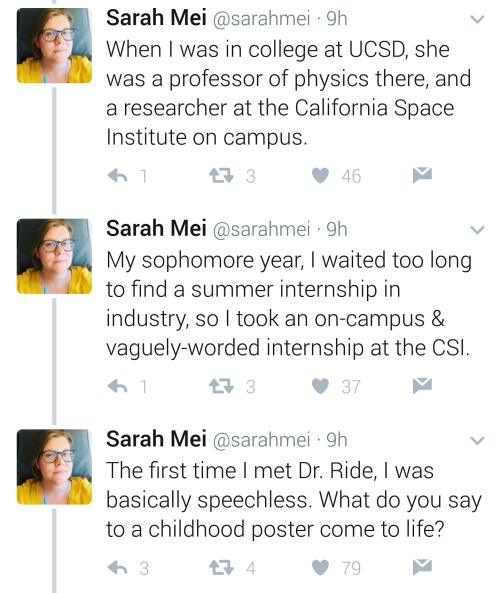
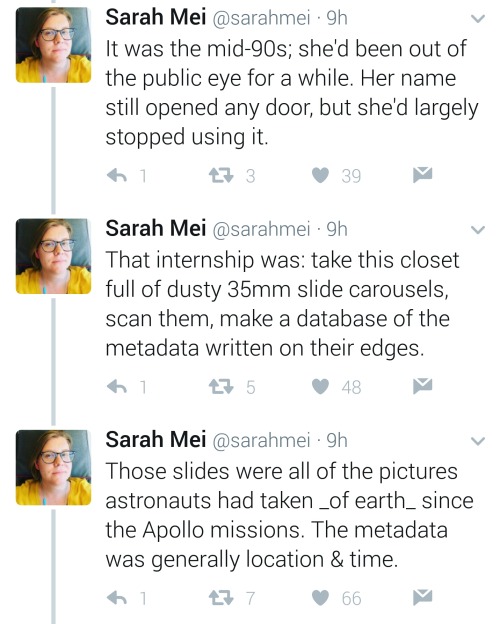
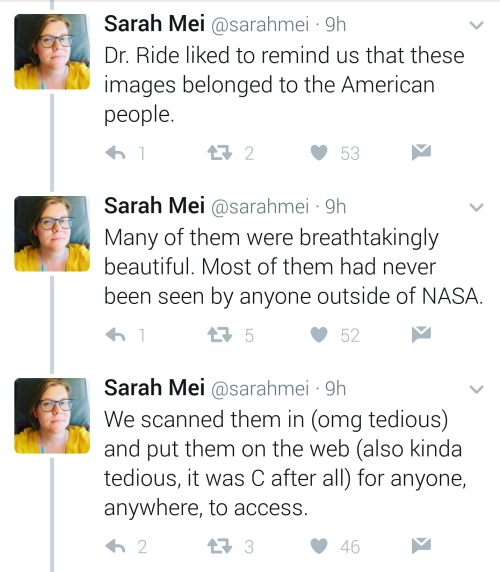



Equal opportunity benefits can be far-reaching
https://twitter.com/sarahmei/status/818682610712866817

Stars are too distant to really peer at and they have all that radiation and heat and blinding light and such so it’s doubtful that we will ever be able to prod the Sun, but astronomers can certainly classify what stars we’ve been able to observe! This is the first part of a two-part series on star classification systems. This podcast focuses on variable stars, how they were discovered, the awesome women who started developing the basis of a major star classification system, and what variable stars did for our understanding of the universe.
There is a lot of technical talk and I did my best to make it comprehensible but you can absolutely hit me up with questions if you have them! I’m also on Twitter at @HDandtheVoid if you’d rather ask me there. And go ahead and check out the podcast on iTunes, rate it or review it if you’d like, and subscribe! I’ll always post all the extras here on tumblr but iTunes might be more convenient for downloading and podcast apps and all that good stuff.
Below the cut is some elaboration on the episode itself, including my sources, music credits, a BIG glossary, a quote on women and emotional labor that really hits home for me, and a transcript. I mention a couple of books and quote a couple people in this episode so if you want to see that written down, those sources are there as well. Let me know what you think of this episode, let me know what you think I should research next*, tell me a fun space fact… anything’s helpful!
*(The June 19th podcast is already set, it’s going to be part 2 on star classifications, but in July I could start talking about things like spectroscopy, planets, dark matter, or I have a book in at the library on longitude.)
Glossary:
arcsecond - an infinitesimal measurement of a degree; in 1 degree there are 3,600 arcseconds.
cosmic distance measurements: light-years - a way to imagine distance scales on an astronomical level; the distance light can travel in one year, or about 6 trillion miles. parsecs - a measurement of distance on an astronomical scale; the distance to a star that shifts by one arcsecond from one side of Earth’s orbit to the other. It’s more common than using light-years when discussing deep space astronomy. One parsec is about 19 trillion miles (30 trillion kilometers), a bit over 3 light-years.
magnitude - the measurement of a star’s brightness as seen from earth. The brighter it is, the lower its magnitude value; the Sun has an apparent magnitude of -27.
Malmquist Bias - the stars that are visible in a cluster are the brightest ones. Astronomers rely on them to compute average luminosity, but the fact that they’re the brightest ones inevitably skews the results.
parallax - the apparent shift of an object when viewed through two different lines of sight.
radial velocity - the speed at which a star is moving away from or towards Earth.
standard candle - a kind of celestial object that has a known luminosity due to some characteristic that the entire class of objects possesses.
stellar photometry - measuring and recording the magnitude of stars.
triangulation - a technique to measure the distance of an object by observing it from two different locations, knowing the distance between both observation locations and measuring the angle at which the distant object moves (its parallax angle).
variable stars: variable stars - stars that change brightness. Reasons for the brightness changes vary, and certain types of variable stars can be used to determine relative distance. They are either intrinsic (when a change in brightness is caused by a star’s own physical changes, like pulsation or eruption) or extrinsic (when the variance has an external cause, such as an eclipse of one star by another or stellar rotation). Cepheid variables - variable stars with a period between 1 and 70 days, with light variations from 0.1 to 2 magnitudes. They’re massive, with a high luminosity and are usually classified between F and G or K. They obey the period-luminosity relationship and played a major part in calculating distances to far-away galaxies as well as helping to determine the age of the Universe. eclipsing binaries - binary systems of stars where the components regularly eclipse one another, causing an apparent decrease in the brightness of the system. irregular variables - variable stars, typically red giants, without a measurable period to their luminosity. Long Period Variables - LPVs have periods ranging from 30 to 1,000 days. They’re red giants or supergiants, typically classified M, R, C, or N. There are subclasses, too: Mira, which have light variations of more than 2.5 magnitudes and are the future evolution of our own star, the Sun; and semiregular, which have some regular periods and some irregular light variation and have light variations less than 2.5 magnitudes. RR Lyrae - variable stars with a period of 0.05 to 1.2 days and a light variation between 0.3 and 2 magnitudes. They’re older and smaller than Cepheids, and are white giant stars typically classified as A. RV Tauri - variable stars that have periods between 30 and 150 days, light variation up to 3 magnitudes, and possible cycle variations that can be hundreds or thousands of days long. They’re yellow supergiants classified between G and K.
cataclysmic variables: dwarf nova - a close binary system of a red dwarf, a white dwarf, and an accretion disk around the white dwarf. They brighten by 2 to 6 magnitudes depending on the stability of the disk, which loses material to the white dwarf. nova - a close binary system of a white dwarf and a secondary star that’s a little cooler than the Sun. The system brightens 7 to 16 magnitudes in 1 to 100 days, and then the star fades slowly to the initial brightness over a period of several years or decades. At maximum brightness, it’s similar to an A or F giant star. Recurrent novae are similar to this category of variable but have several outbursts during their recorded history. R Coronae Borealis - an eruptive variable, a supergiant star that is hydrogen-poor and carbon-rich and spends most of its time at maximum light, fading as much as 9 magnitudes at irregular intervals. Most often classified between F and K or R. supernova - a massive star that explodes with a magnitude increase of 20 or more. Supernovae have led us to realize that the expansion of the Universe is accelerating. symbiotic stars - close binary systems of a red giant and a hot blue star. They have nova-like outbursts up to 3 magnitudes.
Script/Transcript
Sources:
What stars are made of via NASA
Stars, Cepheid Variable by T. Lloyd Evans via the California Institute of Technology aka CalTech
Variable stars via the Australia Telescope National Facility
American Association of Variable Star Observers website. I used a couple of pages from this one but the whole organization is kinda on the nose.
Stellar magnitude via EarthSky
A star magnitude scale via Harvard
Harvard Observatory’s Astronomical Photographic Plate Collection, which has a history of the collection and the women computers.
Definitions and differences for parsecs and light-years, and a description of parallax and triangulation via EarthSky
Standard candle breakdowns via some magical wonderful person with the best accessible online science book project I have ever encountered. Mad props to whoever is doing this, it’s a noble cause.
Info on Walter Baade via the Online Archives of California
A very math-y breakdown of the Malmquist Bias in the article “Observational Selection Bias Affecting the Determination of the Extragalactic Distance Scale” by P. Teerikorpi, published 1997
Johnson, George. Miss Leavitt’s Stars. Atlas Books: NY, 2005.
Henrietta Swan Leavitt quote: “It is worthy of notice [that] the brighter variables have the longer periods” (38).
“If a theory or observation seemed to suggest that we, the observers, happen to occupy an exalted place in the heavens, then it was probably wrong” (110)
Edwin Hubble quote: “With increasing distance, our knowledge fades, and fades rapidly. Eventually, we reach the dim boundary—the utmost limits of our telescopes. There, we measure shadows, and search among ghostly errors of measurements for landmarks that are scarcely more substantial” (130)
Pickover, Clifford A. “Leavitt’s Luminosity Law.” Archimedes to Hawking: Laws of Science and the Great Minds Behind Them. Oxford UP: NY, 2008. 475.
Soba, Dava. The Glass Universe: How the Ladies of the Harvard Observatory Took the Measure of the Stars. Viking: New York, 2016.
From Claire Messud’s The Woman Upstairs (I haven’t read the book, I just collect quotes, so this isn’t me endorsing the book; I know nothing about it except this paragraph): “I’m a good girl, I’m a nice girl, I’m a straight-A, strait-laced, good daughter, good career girl, and I never stole anybody’s boyfriend and I never ran out on a girlfriend, and I put up with my parents’ shit and my brother’s shit, and I’m not a girl anyhow, I’m over forty fucking years old, and I’m good at my job and I’m great with kids and I held my mother’s hand when she died, after four years of holding her hand while she was dying and I speak to my father every day on the telephone–every day, mind you, and what kind of weather do you have on your side of the river, because here it’s pretty gray and a bit muggy too? It was supposed to say ‘Great Artist’ on my tombstone, but if I died right now it would say ‘such a good teacher/daughter/friend’ instead; and what I really want to shout, and want in big letters on that grave, too, is FUCK YOU ALL.”
Intro Music: ‘Better Times Will Come’ by No Luck Club off their album Prosperity
Filler Music: 'River Man’ by Nick Drake off his album Five Leaves Left.
Outro Music: ‘Fields of Russia’ by Mutefish off their album On Draught
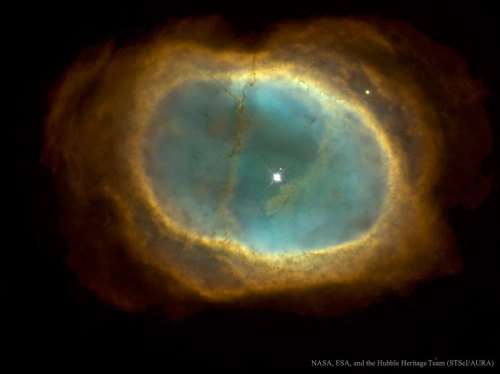
NGC 3132: The Eight Burst Nebula : Its the dim star, not the bright one, near the center of NGC 3132 that created this odd but beautiful planetary nebula. Nicknamed the Eight-Burst Nebula and the Southern Ring Nebula, the glowing gas originated in the outer layers of a star like our Sun. In this representative color picture, the hot blue pool of light seen surrounding this binary system is energized by the hot surface of the faint star. Although photographed to explore unusual symmetries, its the asymmetries that help make this planetary nebula so intriguing. Neither the unusual shape of the surrounding cooler shell nor the structure and placements of the cool filamentary dust lanes running across NGC 3132 are well understood. via NASA
js










Cassini prepares for final orbital “Grand Finale” at Saturn.
Erik Wernquist, the same filmmaker who created 2014’s “Wanderers” and a stunning New Horizons promotional film in 2015, has created a new video highlighting NASA’s Cassini mission’s final days at Saturn. The Cassini spacecraft will begin its final series of orbits to cap a 13-year groundbreaking science mission known as the Grand Finale. For the first time ever in Cassini’s time at Saturn, the spacecraft will fly in between the planet’s rings and atmosphere. No spacecraft has ever before flown in this region of any of the solar system’s ringed planets. After 20 orbits, Cassini will dive into Saturn’s upper atmosphere September 15 where it will be destroyed. In 2008, mission managers explored a range of End of Mission scenarios that would protect Saturn’s moon’s from Earthly contaminants before ultimately deciding on atmospheric reentry. Cassini began her End of Mission manoeuvres on November 26, 2016, when it began the first of 20 ring-grazing orbits. A close flyby of Titan April 22 will alter the spacecraft’s trajectory to begin the first of 23 orbits in the Grand Finale, which will begin April 26.

Cassini launched from Earth on October 20, 1997, and entered Saturn orbit July 1, 2004. 16 days later, the European-built Huygens probe attached to the spacecraft landed on Titan, becoming the first probe to land in the outer solar system. Originally scheduled for a four-year mission ending in 2008, Cassini received two mission extensions in 2008 and 2010, with the latter ending in 2017. With the spacecraft’s fuel reserves low, the Cassini team decided to end the mission. P/C: JPL/Erik Wernquist

-
 sonicsoundscapes liked this · 6 years ago
sonicsoundscapes liked this · 6 years ago -
 delta--scarelines liked this · 6 years ago
delta--scarelines liked this · 6 years ago -
 purified-zone liked this · 6 years ago
purified-zone liked this · 6 years ago -
 just-a-zuki liked this · 6 years ago
just-a-zuki liked this · 6 years ago -
 killingjod liked this · 6 years ago
killingjod liked this · 6 years ago -
 celestialcontrail liked this · 6 years ago
celestialcontrail liked this · 6 years ago -
 rahkshirock reblogged this · 6 years ago
rahkshirock reblogged this · 6 years ago -
 arrows-for-pens liked this · 6 years ago
arrows-for-pens liked this · 6 years ago -
 zenosanalytic reblogged this · 6 years ago
zenosanalytic reblogged this · 6 years ago -
 bortzofcourse liked this · 6 years ago
bortzofcourse liked this · 6 years ago -
 rutilation reblogged this · 6 years ago
rutilation reblogged this · 6 years ago -
 rutilation liked this · 6 years ago
rutilation liked this · 6 years ago -
 zenosanalytic liked this · 6 years ago
zenosanalytic liked this · 6 years ago -
 arsushi reblogged this · 6 years ago
arsushi reblogged this · 6 years ago -
 auberginehedgehog liked this · 7 years ago
auberginehedgehog liked this · 7 years ago -
 bajssworld liked this · 7 years ago
bajssworld liked this · 7 years ago -
 irishboi28-blog reblogged this · 7 years ago
irishboi28-blog reblogged this · 7 years ago -
 disappearedsock reblogged this · 7 years ago
disappearedsock reblogged this · 7 years ago -
 zsielous liked this · 7 years ago
zsielous liked this · 7 years ago -
 billysquirrel liked this · 7 years ago
billysquirrel liked this · 7 years ago -
 ocfos liked this · 7 years ago
ocfos liked this · 7 years ago -
 ocfos reblogged this · 7 years ago
ocfos reblogged this · 7 years ago -
 silvernis reblogged this · 7 years ago
silvernis reblogged this · 7 years ago -
 latenightowl reblogged this · 7 years ago
latenightowl reblogged this · 7 years ago -
 one-girly-geek reblogged this · 7 years ago
one-girly-geek reblogged this · 7 years ago -
 daydreamsonacloudyday reblogged this · 7 years ago
daydreamsonacloudyday reblogged this · 7 years ago -
 ajd1219 reblogged this · 7 years ago
ajd1219 reblogged this · 7 years ago -
 ajd1219 liked this · 7 years ago
ajd1219 liked this · 7 years ago -
 skittyblackfire reblogged this · 7 years ago
skittyblackfire reblogged this · 7 years ago -
 skittyblackfire liked this · 7 years ago
skittyblackfire liked this · 7 years ago -
 samhawke reblogged this · 7 years ago
samhawke reblogged this · 7 years ago -
 fru-frulin-blog liked this · 7 years ago
fru-frulin-blog liked this · 7 years ago -
 aura-of-mystique liked this · 7 years ago
aura-of-mystique liked this · 7 years ago -
 flamesofatimelord reblogged this · 7 years ago
flamesofatimelord reblogged this · 7 years ago -
 pink-buizel reblogged this · 7 years ago
pink-buizel reblogged this · 7 years ago -
 prcphetam-blog liked this · 7 years ago
prcphetam-blog liked this · 7 years ago -
 qcity-blackbird liked this · 7 years ago
qcity-blackbird liked this · 7 years ago -
 strixus liked this · 7 years ago
strixus liked this · 7 years ago -
 havenskid19 liked this · 7 years ago
havenskid19 liked this · 7 years ago -
 teratocybernetics reblogged this · 7 years ago
teratocybernetics reblogged this · 7 years ago -
 mrbotanyb liked this · 7 years ago
mrbotanyb liked this · 7 years ago -
 intherainonceagain liked this · 7 years ago
intherainonceagain liked this · 7 years ago -
 lifeofpayne reblogged this · 7 years ago
lifeofpayne reblogged this · 7 years ago -
 tookingabout reblogged this · 7 years ago
tookingabout reblogged this · 7 years ago -
 clickoliver reblogged this · 7 years ago
clickoliver reblogged this · 7 years ago -
 coco-sebulitis reblogged this · 7 years ago
coco-sebulitis reblogged this · 7 years ago -
 little-peachy-panda liked this · 7 years ago
little-peachy-panda liked this · 7 years ago
A podcast project to fill the space in my heart and my time that used to be filled with academic research. In 2018, that space gets filled with... MORE SPACE! Cheerfully researched, painstakingly edited, informal as hell, definitely worth everyone's time.
243 posts



